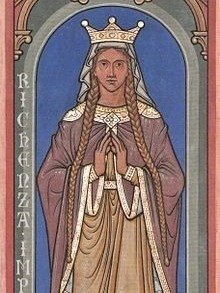Arbre généalogique Snelder - Versteegh » Emperor Lothair II of Supplinburg (1075-1137)
Données personnelles Emperor Lothair II of Supplinburg
- Il est né en l'an 1075.
- Il est décédé en l'an 1137, il avait 62 ans.
- Un enfant de Gebhard of Supplinburg et Hedwige of Formbach
Famille de Emperor Lothair II of Supplinburg
Il avait une relation avec Richenza of Northeim.
Enfant(s):
Notes par Emperor Lothair II of Supplinburg
https://en.wikipedia.org/wiki/Lothair_II,_Holy_Roman_Emperor
Lothair II or Lothair III[a] (before 9 June 1075 – 4 December 1137), known as Lothair of Supplinburg, was Holy Roman Emperor from 1133 until his death. He was appointed Duke of Saxony in 1106 and elected King of Germany in 1125 before being crowned emperor in Rome. The son of the Saxon count Gebhard of Supplinburg, his reign was troubled by the constant intriguing of the Hohenstaufens, Duke Frederick II of Swabia and Duke Conrad of Franconia. He died while returning from a successful campaign against the Norman Kingdom of Sicily.
Little is known of Lothair's youth. His father joined the Saxon Rebellion against the ruling Salian dynasty and died on 9 June 1075 in the Battle of Langensalza, fighting troops loyal to Emperor Henry IV. Shortly thereafter, Lothair was born posthumously at Unterlüß.[4] In 1100 he married Richenza, daughter of Count Henry of Northeim and Gertrude of Brunswick, heiress of the Brunonids.[5]
After years of purchasing lands or gaining them via inheritance or marriage alliances throughout Saxony, Lothair gained the domains of the House of Billung, the Counts of Northeim and the Brunonids, and became one of the dominant landowners in the North German duchy. He backed the emperor's son Henry V during the disempowerment of his father Henry IV and in turn was made Duke of Saxony upon the death of Magnus of Billung in 1106.[6] Emboldened by the promotion and incensed over the imposition of a new tax on ducal lords, however, Duke Lothair subsequently revolted against Emperor Henry's rule and denied his ability to rule Saxony during the Investiture Controversy. He acted autonomously, vesting Count Adolf of Schauenburg with Holstein in 1110, was temporarily deposed in 1112 but reinstated after he tactically submitted himself to the rule of Henry V. In 1115 however, he joined the rebellious Saxon forces which defeated those of the Emperor in the Battle of Welfesholz.[7] When in 1123 Henry V vested Count Wiprecht of Groitzsch with the Margraviate of Meissen, Lothair enforced the appointment of Conrad of Wettin and ceded the March of Lusatia to Count Albert the Bear.
After the death of Emperor Henry V in 1125, Lothair was viewed by the Imperial chancellor, the Archbishop of Mainz, as a perfect candidate.[8] As an extensive landowner all over Saxony, he brought power to the table, but he was old (slightly over fifty years of age) and had no male issue, potentially making him malleable for the nobility. He was therefore elected King of the Romans after a contentious power struggle with Duke Frederick II, Duke of Swabia, head of the rising House of Hohenstaufen.[9] His election was notable in that it marked a departure from the concept of hereditary succession.[10] Somewhat naive concerning the complex power struggle between the papacy and the empire, Lothair also consented to several symbolic acts that were subsequently interpreted by Rome as signaling acceptance of papal confirmation of his position.[9]
A campaign undertaken in the same year against Bohemia ended in defeat, a weak start by Lothair. Among those captured by the Bohemians was Albert of Ascania, future Margrave of Brandenburg.
Duke Frederick II and Conrad were the two contemporary male Hohenstaufen, by their mother Agnes were grandsons of late Emperor Henry IV and nephews of Henry V. Frederick attempted to succeed to the throne of the Holy Roman Emperor (formally known as the King of the Romans) through a customary election, but lost to the Saxon duke Lothair of Supplinburg. A civil war between Frederick's dynasty and Lothair's ended with Frederick's submission in 1134.
With both Saxon and Bavarian origins, the Süpplingenburg dynasty was a political opponent of the Salian dynasty and the Swabian House of Hohenstaufen. During his reign, a succession dispute broke out between the House of Welf and the Hohenstaufens; the latter were led by Frederick II, Duke of Swabia and his brother Duke Conrad of Franconia.[11] The Staufens, in addition to claiming the private Salian lands which clearly fell to them, also claimed all of the crown lands they had gained under Henry IV and Henry V. Lothair attempted to seize the crown lands following approval from a group of nobles meeting in Regensburg, which provoked Staufen reaction. Lothair then moved further. Frederick II was placed under the Imperial ban, Conrad was deprived of Franconia, and Lothair appointed his ally Conrad I, Duke of Zähringen as rector of Burgundy.
The Staufens, with the support of their own lands, many Imperial Free Cities, the Duchy of Austria, and the Duchy of Swabia, got Duke Conrad elected as "anti-king" Conrad III. In 1128 Conrad went to Italy, to be crowned King of Italy by Anselm V, Archbishop of Milan.[9][11] Lothair took advantage of Conrad's absence and weak position by attacking the Staufens in Germany. In 1129 he took two strong Staufen cities, Nurembergand Speyer. Conrad failed to make anything of his visit to Italy, and returned in 1130 with nothing to show for it, which assured at least a partial victory for Lothair.[11]
Returning to Germany, he set out to create peace. The Staufen brothers, falling short on resources, were compelled to submit.[16] The Reichstag in Bamberg in 1135 pardoned the two brothers and restored them to their lands. In return, they recognized Lothair as emperor, Conrad abandoned his title of King of Italy,[17] and both promised to assist him in another Italian campaign, before a ten-year ‘Landpeace’ was declared.
In 1136, at the insistence of Innocent and Byzantine Emperor John II Comnenus, the campaign against Roger of Sicily began.[6] Two main armies, one led by Lothair, the other by his son-in-law Henry X, Duke of Bavaria("Henry the Proud"), entered Italy.[16] On the river Tronto, Count William of Loritello did homage to Lothair and opened the gates of Termoli to him. This was followed by the submission of Count Hugh II of Molise. Advancing deep into the southern part of the peninsula, the two armies met at Bari, and continued further south in 1137. Roger offered to give Apulia as a fief of the Empire to one of his sons and give another son as a hostage; terms which Lothair refused after being pressured by Innocent.
The German troops, however, were adamant against campaigning during the hot summer and revolted. The emperor, who had hoped for the complete conquest of Sicily, instead separated Capua and Apulia from Roger's kingdom and gave them to Roger's enemies.[18] Innocent, however, protested, claiming that Apulia fell under papal claims; the two eventually jointly enfeoffed the duchy to Rainulf of Alife.[18] Lothair occupied Salerno from August to October 1137. There he had copper coins (follari) minted in his name.[19]
Returning to Germany, Lothair died while crossing the Alps on 4 December 1137.[20] His body was boiled to prevent putrefaction,[21] and his bones were carried to the monastery church of Saints Peter and Paul at Königslutter, which he endowed as his burial church and for which he laid the cornerstone in 1135.
Shortly beforehand, he gave his Tuscan Matildine lands to Henry the Proud of Bavaria, and his last acts were to give him also the Duchy of Saxony and the imperial regalia. However, the kingship subsequently ended up in the hands of the Staufens, destroying Lothair's hopes for a powerful Welf hereditary monarchy.
The emperor's most long-lasting contribution to Germany came from his actions in the north and east. Being a Saxon, he gave more attention to the region than previous emperors. Even before becoming German king, he had given control of Holstein and Stormarn to Adolf I of Schauenburg. In 1134 he appointed the Ascanian Albert the Bear as Margrave of Brandenburg. In 1136 he appointed Conrad the Great of Wettin, already margrave of Meissen, to the position of margrave of Lausitz, uniting the two marches. In addition, he petitioned the pope to expand the rights of the Archbishopric of Bremen and Archbishopric of Magdeburg in the area. King Eric II of Denmark was made a vassal of the emperor in 1135, becoming a member of the Reichstag. Successful diplomatic intervention by Lothair in ending war between Poland and Bohemia/Hungary resulted in the Polish Duke's Bolesław III Wrymouth payment of Pomeranian tribute that was long overdue. In addition, the Polish Duke had to accept Pomerania ;and Rügen as fiefs of the Empire.
The Süpplingenburg dynasty was only short-living. By his wife, Richenza of Northeim, Lothair had only one surviving child, a daughter Gertrude, born 18 April 1115. To secure Welf support for his election as king, Lothair married Gertrude to Henry X, Duke of Bavaria, on 29 May 1127.[22] Their only son was Henry the Lion.[22]
After Lothair's death in 1137, the Hohenstaufen Conrad was elected King as Conrad III. When Henry the Proud, son-in-law and heir of Lothair and the most powerful prince in Germany, who had been passed over in the election, refused to acknowledge the new king, Conrad III deprived him of all his territories.
Barre chronologique Emperor Lothair II of Supplinburg
 grand-parents
grand-parents
 parents
parents
 frères/soeurs
frères/soeurs
 enfants
enfants
Ancêtres (et descendants) de Lothair II of Supplinburg
Lothair II of Supplinburg  | ||||||||||||||||||||||||||||||||||
Richenza of Northeim | ||||||||||||||||||||||||||||||||||
Parenté Emperor Lothair II of Supplinburg
- Lothair II of Supplinburg est le arrière(x47)-petit-fils de Titus Manlius Imperiosus Torquatus:Titus Manlius Imperiosus TorquatusTitus Manlius TorquatusTitus Manlius TorquatusAulus Manlius TorquatusTitus Manlius TorquatusDecimus Junius Silanus ManlianusMarcus Junius Silanus consulMarcus Junius SilanusMarcus Junius Silanus consulMarcus Junius SilanusJunia Calvina EquitusGaius SallustiusGaius Ummidius Quadratus SallustiusGaius Ummidius Quadratus Annianus VerusGaius Ummidius Quadratus Annianus Verus FulviusUmmidia Commificia AntoniaPendania Pedanius FuscusMariana MinorAurelia PompeianaClaudiaConstantius I Chlorus of RomeUnkownProcopius UsurperProcopiusProcopius II Magister Militum of ByzantiumProcopius Anthemius I of the of the Western Roman EmpireAlypia Princess of the of RomeCaratene Agrippina of NarbonneClothilde of BurgundyChlothar I of the FranksCharibert I of ParisBilichildeArnoald of MetzDodaAnsegisel of the FranksPepin II of HerstalCharles Martel of the FranksPepin The Short III of the FranksCharlemange (Charles I) of the FranksLouis I the Pious de Aquitaine of FranceLouis "The German"" II of the East FranksGisela of the East FranksCunigunde of SwabiaBerthold of BavariaKunigunde of BavariaBerthold I of FormbachThiemo I of FormbachFrederick of FormbachHedwige of FormbachLothair II of Supplinburg
Les données affichées n'ont aucune source.
Sur le nom de famille Of Supplinburg
- Afficher les informations que Genealogie Online a concernant le patronyme Of Supplinburg.
- Afficher des informations sur Of Supplinburg sur le site Archives Ouvertes.
- Trouvez dans le registre Wie (onder)zoekt wie? qui recherche le nom de famille Of Supplinburg.
Roel Snelder, "Arbre généalogique Snelder - Versteegh", base de données, Généalogie Online (https://www.genealogieonline.nl/stamboom-snelder-versteegh/I506842.php : consultée 28 mai 2024), "Emperor Lothair II of Supplinburg (1075-1137)".

